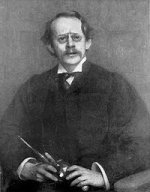|
 Joseph John Thomson was a Nobel Prize winning physicist who discovered the electron. He was born on December 18, 1856 in Cheetham Hill, Manchester, England. His parents were Scottish, and his father died when he was only 16 years old. Thomson studied engineering at Owens College, now the University of Manchester in 1870. In 1876, he moved on to Trinity College, Cambridge. Here, he earned a degree in mathematics. Joseph John Thomson was a Nobel Prize winning physicist who discovered the electron. He was born on December 18, 1856 in Cheetham Hill, Manchester, England. His parents were Scottish, and his father died when he was only 16 years old. Thomson studied engineering at Owens College, now the University of Manchester in 1870. In 1876, he moved on to Trinity College, Cambridge. Here, he earned a degree in mathematics.
In 1883, after earning a graduate degree, Thomson became the Cavendish Professor of Physics. He married Rose Elisabeth Paget, the daughter of a physician and professor at Cambridge. They had a son and a daughter.
During his time at Cambridge, Thomson performed his most famous experiment. He discovered the subatomic particles, electrons using a cathode ray. In his first cathode ray experiment, he attempted to separate the negative charge evident in the ray from the ray itself. He found that it was impossible today. In the second experiment, Thomson attempted to show that a cathode ray is deflected in an electric field. Previous such experiments had failed and Thomson was successful because he created a complete vacuum for the cathode ray tube. This experiment indicated that the ray was made of negatively charged particles. Using different metals for the cathode that created the ray, he was able to prove that these particles are part of all matter.
In a third experiment with the cathode ray, Thomson calculated the mass to charge ratio of the electrons. He found that they were very light particles, far lighter than hydrogen atoms. In 1897, the results of his work were made public and caused a sensation. He won the Nobel Prize for Physics for this work in 1906.
Thomson continued his study of rays. He created an ionized beam of neon and deflected it through an electric field. He found that two beams were created, indicating that neon had two different masses. He had discovered isotopes. This work led to the development of mass spectrometry, a technique for sorting particles by mass and charge.
Thomson received many honors for his work including becoming a fellow and then president of the Royal Society. He was also well known for being a great teacher. Seven of his students went on to win the Nobel Prize. He became the Master of Trinity College at Cambridge in 1918 and remained in that position until his death. He died on August 30, 1940 and is buried in Westminster Abbey next to Isaac Newton.
Image: Sir Joseph John Thompson (1856-1940). Portrait by Arthur Hacker.
|